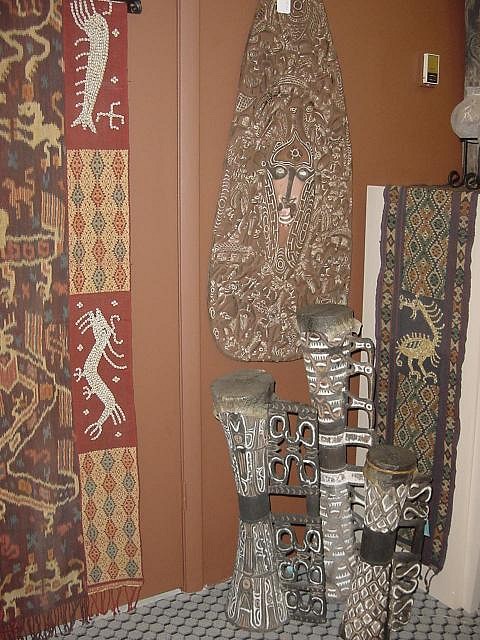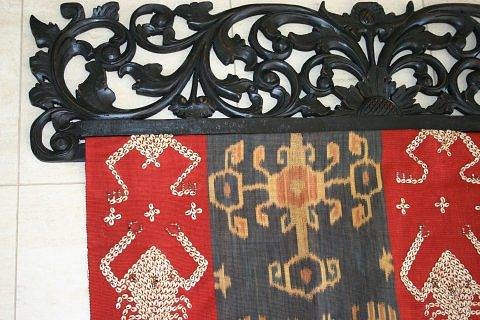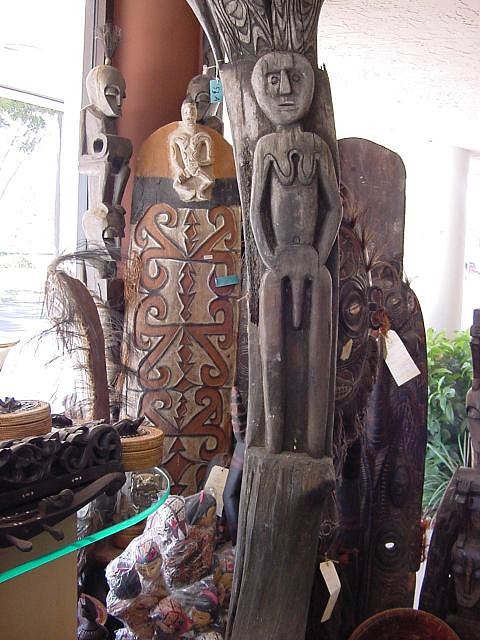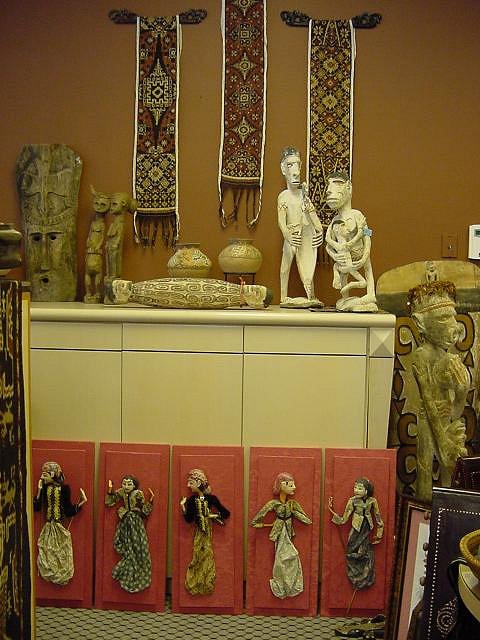
Story board (back wall)
"Storyboards are a tradition of the Kambot area in the lower Sepik. A storyboard is a carved wooden board which literally tells a story. Storyboards are displayed in Haus Tambarans as decorations. Along the Keram River, spirits and ancestors were depicted traditionally on sago spathe or bark, as paintings in a form of story book. However, because bark is easily broken and easily rubbed of, the Kambot people shifted, during the 1960’s, to carving the tales of their life and ancestors on wood, in order to produce a more durable form of artwork. It resulted in more than a shift from bark paintings to carved wooden boards, as seen here, and the new tradition stuck. Whereas bark paintings were wholly spirits boards, the wooden boards of today are simply depictions of everyday village life, often humorous, with spirit figures being shown very occasionally on the men's house gables. Scenes represent fishing, hunting, all sorts of animals such as cuscus, cassowary, pig, snake hiding within the shrubbery, women preparing sago flour in front of the houses and general everyday life. These are set against a backdrop of the village structures and surrounding jungle habitat. Unlike the older forms of carving they are only decorative and appear to have no special religious significance. The most prized ones are very large, have been carved by the best sculptors in the village and their carving is intricate, detailed and remarquable since tools used are still very primitive. These are almost always well made, again not withstanding the relatively crude implements used. The new wood art form served to increase the durability, and longevity of the stories so told. The pigments used are clay, charcoal, and lime. The brown storyboard is finished with a natural wax from the milk of the kapiak tree while the details are picked out by white lime and ochres. Every storyboard is unique: no two are the same as they each tell different stories with different characters and settings."
"On the right and left of the story board are textiles from Sumba with inserts of nassa shells: Sumba's elaborate textile tradition finds its most colorful expression along the island's east coast where weavers combine animal and plant motifs with geometric patterns and ethnographic symbolism. What to the western eye is artistic, even fanciful, for the Sumbanese forms the basis of a complicated literacy that is the foundation of their culture. The largest event any Sumbanese is likely to see will be the funeral of his or her raja; the body, having been wrapped in hundreds of textiles and kept through several years of preparations, is buried in an elaborate ceremony. The east of Sumba supports barely a third of the island's population but has the most richly developed textile tradition. In full traditional dress men wear two large blanket-size hinggi, one as a hip cloth, one as a sash. Women wear a tubular lau sarong and a hawala irung sash. Textiles in Sumba have always functioned both as an indication of status and a means of ritual exchange. Colors and motifs worn still denote an individual's position in the island's complex social hierarchy; the number of pieces owned remain a measure of personal wealth. Textiles form part of the ceremonial exchange of gifts between the families of a bride and groom. For funerals, dozens of cloths are interred with the corpse and many more given to and by the hundreds of guests that attend the ceremony. The motifs in a cloth may be geometric, zoomorphic, floral, trade-inspired or ethnographic and the textiles are handwoven out of spun cotton and colored with natural pigments, a few have inserts of shells such as these."
Closeup of textile

"Here is a close up of one so people can see the inserts of nassa shells. It is hanging on a textile bar all handcarved in Lombok."
Description below refers to photo on top of post
"In front, there are 3 asmat drums from Irian jaya: The Asmat's wood carvings and other artifacts are critical in Asmat rituals aimed at correcting imbalances. Their carvings make the unseen visible and allow the Asmat to make direct contact with their ancestors, who grant protection to the living. Their shields, bis poles and many other objects are named for ancestors and treated as powerful manifestations of these spirits. Elaborate rituals and ceremonies surround their activation and use. The magic of these rituals and social ceremonies are an important part of Asmat life, giving them a sense of control over their lives and binding the Asmat society together. Asmat designs are bold and powerful because they represent powerful forces involved in their rituals. Asmat symbols are strongly connected with headhunting and cannibalism. Besides the figures and features of their ancestors, the Asmat also have symbols to represent other creatures which are either carnivorous like the praying mantis, or fruit-eaters. This is because the Asmat associate fruit with the human head. Thus to take a head is to eat the fruits of a tree, and vice versa. Any dark-coloured, fruit-eating animal is therefore a symbolic headhunter: the flying fox, the black king cockatoo, the cuscus or opossum, the hornbill, a special heron and the sea pelican. The tusks of a boar are also a powerful symbol as pig-hunting is equivalent in honour as headhunting. "

" In the second photo is an Asmat shield that was used in battle and an ancestor is represented on top and meant to protect the bearer. Every asmat male child is taught the basic skills for handling wood, such as felling a tree, building a house or constructing canoes, paddles and sago pounders. However, for special objects with ritual meaning and uses, the Asmat call upon the Master Carver or "wow-ipits" ("wow" refers to carving, "ipits" is the word for man). Like the Great Woodcarver Fumer-ipit who created life from wood, the wow-ipits have a similar supernatural life-giving aura. Other villagers who commission carvings must keep the wow-ipit in good spirits to encourage the ancestral spirits to enter his work. This means they must feed the carver and his family for the duration of the work. And feed them well, including delicacies such as sago worms which are a fat grub and tobacco. Nowadays, payment may include a knife, fishing line or an old pair of pants. But carvers lead lives very similar to if not poorer than other villagers. Their main reward is in the prestige they gain for their work. Each Asmat village supports a group of such carvers. A carver may specialise in a particular object, and each has his own style. Because the commissioning of such work usually begins with the cutting of a sago tree and ends with the collection of the sago grubs that grow in it, which takes six weeks, most ritual carvings are completed within this timespan. During this time, though, the carvers may work only when they feel like it. To carve wood, the Asmat used bone and shell. To do the details, they may use the teeth of a particular type of fish or nails salvaged from driftwood. Metals tools are now more common.
In front is a large totem pole from Timor which only a part can be seen, 8 ft tall, and that was once planted at the entrance of a village to warn off evil spirits."

"On back wall hang 3 very rare geringsing sacred cloths: The most prized ikat in Indonesia is the spectacular geringsing textile produced by the double-ikat method in the indigenous Bali Aga village of Tenganan Pegeringsingan, an incredibly time demanding process that is known to only a handful of weavers around the world." (Rest of narration moved to next post to leave room for rest of items in photo.)
"Under the geringsing are 2 pots: Rare traditional terracotta pottery from remote East Timor Island, Indonesia, is one of a kind, completely handcrafted (centuries old process) and adorned with motifs in relief combined with geometrical designs reminiscent of American Indian Pottery usually of men or animals, gecko for example, & hand-painted with local inhancing natural color pigments. It came from the Vermasse region of Timor and was used by the natives of Manatuto to boil water on an outside fire in order to make it ready for human consumption (water borne diseases are a major problem in East Timor, the traditional solution is still to boil the water to make it safe). These pots, which were made with a fine red clay mix combined with river sand & rice husk ash sieved thru a fly screen and formed by hand, still bear some charcoal black marks on the outside from the burns of bonfires made from cow manure, burns which add to the charm and authenticity. The making of strong, sturdy and elegant terracotta pottery was a great part of Timorese culture for many centuries, but ceramic-making facilities as well as ceramics themselves were destroyed during the violence in 1999 (which put a stop to the creation of such wonderful pieces) and most haven’t been reconstructed yet and good pieces of terracotta are much harder to find today as a result.
In front of the pots lays a rare Asmat pillow or headrest all handcarved and made out of mangrove root.
On the left are a few carvings from Timor, very old, and on the extreme right a 5 feet asmat statue of a warrior holding the skull of his enemy in his hands and behind yet another asmat shield and above it, 2 whitish asmat statues, one of a female and her child and the other of a man holding a miniature canoe called wuramon. The “wuramon” or spirit vessel is a type of sculpture found only in interior Asmat areas. Wuramon or “soul ships” resemble dugout canoes in their general shape but are smaller & non-functional. They are only used in ceremonies where the initiates undergo a ritual death/rebirth. There appear to be two general types of these carvings:
-
An empty canoe which is used traditionally during initiation, a ceremony that takes place during the “emak cem” feast, where newly circumcised boys straddle the wuramon letting their blood (from circumcision) flow inside.
-
A canoe carrying one or many figures. The one figure could be sitting or riding above as an onlooker. The many figures are usually sitting, carved in a row: they are mainly human (spirit passengers that take the names of those who have recently died) but they can also be animal or human-animal, for example.
[ Edited by: I dream of tiki 2009-02-21 23:36 ]





